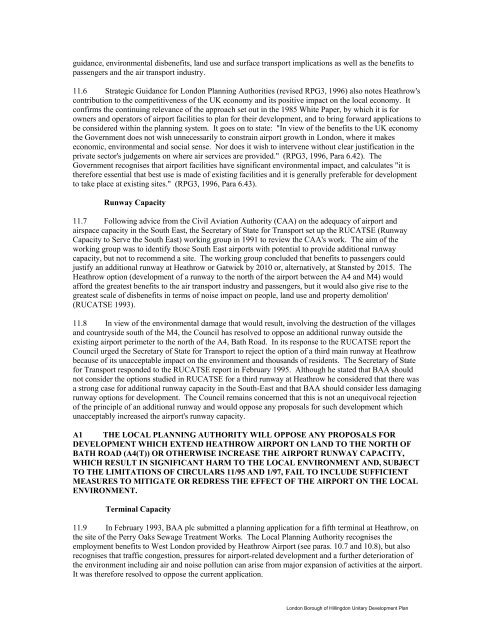HILLINGDON UNITARY DEVELOPMENT PLAN - London Borough ...
HILLINGDON UNITARY DEVELOPMENT PLAN - London Borough ...
HILLINGDON UNITARY DEVELOPMENT PLAN - London Borough ...
You also want an ePaper? Increase the reach of your titles
YUMPU automatically turns print PDFs into web optimized ePapers that Google loves.
guidance, environmental disbenefits, land use and surface transport implications as well as the benefits to<br />
passengers and the air transport industry.<br />
11.6 Strategic Guidance for <strong>London</strong> Planning Authorities (revised RPG3, 1996) also notes Heathrow's<br />
contribution to the competitiveness of the UK economy and its positive impact on the local economy. It<br />
confirms the continuing relevance of the approach set out in the 1985 White Paper, by which it is for<br />
owners and operators of airport facilities to plan for their development, and to bring forward applications to<br />
be considered within the planning system. It goes on to state: "In view of the benefits to the UK economy<br />
the Government does not wish unnecessarily to constrain airport growth in <strong>London</strong>, where it makes<br />
economic, environmental and social sense. Nor does it wish to intervene without clear justification in the<br />
private sector's judgements on where air services are provided." (RPG3, 1996, Para 6.42). The<br />
Government recognises that airport facilities have significant environmental impact, and calculates "it is<br />
therefore essential that best use is made of existing facilities and it is generally preferable for development<br />
to take place at existing sites." (RPG3, 1996, Para 6.43).<br />
Runway Capacity<br />
11.7 Following advice from the Civil Aviation Authority (CAA) on the adequacy of airport and<br />
airspace capacity in the South East, the Secretary of State for Transport set up the RUCATSE (Runway<br />
Capacity to Serve the South East) working group in 1991 to review the CAA's work. The aim of the<br />
working group was to identify those South East airports with potential to provide additional runway<br />
capacity, but not to recommend a site. The working group concluded that benefits to passengers could<br />
justify an additional runway at Heathrow or Gatwick by 2010 or, alternatively, at Stansted by 2015. The<br />
Heathrow option (development of a runway to the north of the airport between the A4 and M4) would<br />
afford the greatest benefits to the air transport industry and passengers, but it would also give rise to the<br />
greatest scale of disbenefits in terms of noise impact on people, land use and property demolition'<br />
(RUCATSE 1993).<br />
11.8 In view of the environmental damage that would result, involving the destruction of the villages<br />
and countryside south of the M4, the Council has resolved to oppose an additional runway outside the<br />
existing airport perimeter to the north of the A4, Bath Road. In its response to the RUCATSE report the<br />
Council urged the Secretary of State for Transport to reject the option of a third main runway at Heathrow<br />
because of its unacceptable impact on the environment and thousands of residents. The Secretary of State<br />
for Transport responded to the RUCATSE report in February 1995. Although he stated that BAA should<br />
not consider the options studied in RUCATSE for a third runway at Heathrow he considered that there was<br />
a strong case for additional runway capacity in the South-East and that BAA should consider less damaging<br />
runway options for development. The Council remains concerned that this is not an unequivocal rejection<br />
of the principle of an additional runway and would oppose any proposals for such development which<br />
unacceptably increased the airport's runway capacity.<br />
A1 THE LOCAL <strong>PLAN</strong>NING AUTHORITY WILL OPPOSE ANY PROPOSALS FOR<br />
<strong>DEVELOPMENT</strong> WHICH EXTEND HEATHROW AIRPORT ON LAND TO THE NORTH OF<br />
BATH ROAD (A4(T)) OR OTHERWISE INCREASE THE AIRPORT RUNWAY CAPACITY,<br />
WHICH RESULT IN SIGNIFICANT HARM TO THE LOCAL ENVIRONMENT AND, SUBJECT<br />
TO THE LIMITATIONS OF CIRCULARS 11/95 AND 1/97, FAIL TO INCLUDE SUFFICIENT<br />
MEASURES TO MITIGATE OR REDRESS THE EFFECT OF THE AIRPORT ON THE LOCAL<br />
ENVIRONMENT.<br />
Terminal Capacity<br />
11.9 In February 1993, BAA plc submitted a planning application for a fifth terminal at Heathrow, on<br />
the site of the Perry Oaks Sewage Treatment Works. The Local Planning Authority recognises the<br />
employment benefits to West <strong>London</strong> provided by Heathrow Airport (see paras. 10.7 and 10.8), but also<br />
recognises that traffic congestion, pressures for airport-related development and a further deterioration of<br />
the environment including air and noise pollution can arise from major expansion of activities at the airport.<br />
It was therefore resolved to oppose the current application.<br />
<strong>London</strong> <strong>Borough</strong> of Hillingdon Unitary Development Plan
















